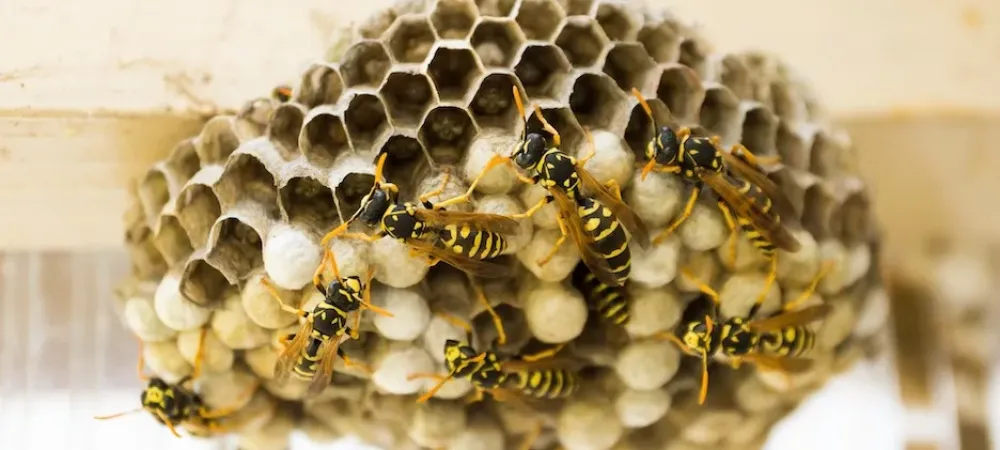Do Wasps Have A Purpose?

Wasps are known for their aggressive behavior and building their nests in inconvenient locations. There are an estimated 30,000 species of wasp in the world and they live everywhere except the polar regions. Everyone is familiar with their creepy appearance and painful stings, and it’s hard to imagine that they serve a purpose for the environment, but they actually do.
Despite their bad reputation, these insects play an important role in the ecosystem. In this blog, we will discuss the following:
- Difference Between Wasps
- Do Wasps Pollinate
- How To Get Rid of Wasps
Differences Between Wasps
We have all seen wasps and hornets before. They come in many colors, but there are only a few that can become nuisances to New York homeowners. Many people don’t know the difference between wasps, yellowjackets, and hornets because if you take a chance to get too close, they have painful stings. Luckily, for you, we will break all of this down so you are able to tell the difference between these aggressive stinging insects.
Yellowjackets
There is a lot of confusion surrounding what a yellowjacket actually is. Paper wasps, which are usually seen around picnic tables in the summer, usually have yellow and black stripes on them but that does not make them a yellowjacket. True yellowjackets are a variety of wasp but are typically smaller than paper wasps. These insects are famous for their aggression and will attack if you get too close to their nest. Since they build their nests underground, homeowners usually come across yellowjacket nests accidentally and painfully. A good rule of thumb is, if you are close enough to identify a yellowjacket then you are too close.
Hornets
A hornet is actually a type of wasp, but not all wasps are hornets. The main difference between hornets and wasps is their size; Hornets are bulkier and larger than wasps. Another notable difference between hornets and wasps is that hornets are entirely social insects while wasps can be solitary or social depending on their species.
Hornets prey on other insects and use their stingers to hunt. This means that they can sting more than once and can cause severe pain and swelling. Hornets usually build their nests in trees, shrubs, or on man-made structures.
Paper Wasp
Wasps have thinner bodies and are often black and yellow in appearance. Many people often confuse paper wasps with yellowjackets but paper wasps are larger and not as aggressive. However, these wasps can be very aggressive if their nest is disturbed. Unlike bees, wasps do not lose their stinger, allowing them to sting multiple times.
Paper wasps get their name from their nests, which consist of a paper-like material. They typically build their nests under roof lines, behind shutters, and under the gutters of your house.
Do Wasps Pollinate?
Wasps have a diet that ranges from fruit to insects. They also love sweet and sugary foods. That’s why you see them buzzing around your beer and soda cans at summer picnics. Wasps also enjoy feeding on nectar from time to time, making them accidental pollinators. They do not have hairs on their bodies like bees that help with collecting pollen but they still contribute.
Wasps are omnivorous, meaning they feed on a variety of different food sources such as fruit, nectar, sugary food, and other insects. Despite their bad reputation, wasps can play an important factor for the environment, but this does not mean you should have them around your property. They play an important role in controlling other insect populations by feeding on pests that can destroy crops. Farmers actually enlist the help of wasps to control caterpillars in their fields.
How to Get Rid of Wasps
Although wasps are beneficial insects, when they build their nests too close to humans it can spell trouble. Running into a wasp nest while you are trying to repair your house can be dangerous, especially if you are on a ladder or the roof. Here are some steps you can take to prevent wasps from building their nests around your home.
Seal Up Cracks & Crevices
Wasps seek out sheltered places to build their nests. One of the most common places is in and around the roof of our homes. Wasps can squeeze through small cracks in fascia boards or roof vents and get into your walls and crawl spaces. From there, they can make their way into your home and give you an unpleasant surprise. To prevent wasps and hornets from getting in your home, make sure you seal all cracks and crevices with caulk. Some wasps can chew through caulk and spray foam insulation so keep a vigilant eye out.
Keep Trash Cans Covered and Limited
Wasps are often found in our garages in the summer going through our trash. They can get trapped in your garage and even make their way into your home. Make sure you keep your trash cans covered and move them outside if there is something in it that is attracting wasps.
Professional Pest Control
When dealing with stinging insects such as wasps, hornets, and yellowjackets you must be very careful and should enlist the help of a professional exterminator. At Eco Serve Pest Control we have been offering premium stinging insect control for western New York since 2000. If you are having a problem with stinging insects give us a call at 716-293-2500 or leave us a message on our site.

